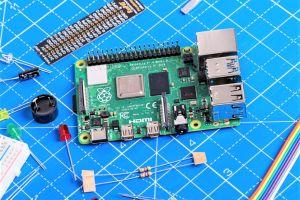Your Node, Your Keys, Your Bitcoin: Raspberry Pi
Raspberry Pi is one of the most popular mini-computers on the market. The small, cost-effective machine is as powerful as any regular desktop computer, with the newest iteration able to support a wide range of features. It is also possible to run a Bitcoin and a Lighting Network (LN) node using this tiny machine.

In this article, you will learn the basics about Raspberry Pi and what do you need in order to set up a node that enables you to accept bitcoin and LN payments.
What is Raspberry Pi?
The Raspberry Pi is one of the most favorably reviewed mini-computers on the planet. The credit-card-sized computer started out as a project at the University of Cambridge‘s Computer Laboratory in 2006. The project was initiated by a group of computer scientists who were concerned about the technical knowledge, displayed by computing undergraduate students. The incoming classes knew how to utilize computers but displayed a lack of understanding of the inner workings and technological specifications of the machines.
To combat this, Eben Upton, Rob Mullins, Jack Lang, and Alan Mycrof, among others, began working on a design for a computer best-suited for academia. The initial design process was a six-year-long undertaking as the scientists worked to create a device that would be cost-effective yet powerful enough to introduce students to technical aspects of computer science such as programming and 3D modeling. This was the birth of the Raspberry Pi Foundation.
Raspberry Pi Foundation is a non-profit organization that handles the design and manufacture process for the mini-computer. The Raspberry Pi prototype was made available to the public in February 2012 to a resoundingly positive response. The device is typically released in Model A and Model B versions per each iteration with the latter typically being the more powerful.
The Raspberry Pi was initially named in accordance with the old tradition of naming computers systems after fruit as well as the inceptive proposition to use python as the only supported programming language, is a low cost, credit-card sized device which can be connected to a computer monitor or TV for display purposes. It utilizes a standard keyboard and mouse which are connected to the device.
Since the 2012 prototype, a number of versions have been released to the market with the latest iteration, the Raspberry Pi 4, being the most powerful and advanced of the models. Technological amendments have ensured that despite its size and low-cost, the mini-computer continues to capture the imagination of scientists, students, and tinkerers worldwide. The device holds the distinction of being Britain’s best-selling computer.
The Raspberry Pi 4
The Raspberry Pi 4 release was on June 24, 2019. The foundation describes it as a “capable little device that enables people of all ages to explore computing and to learn how to program in languages like Scratch and Python.” The device is being classified as a desktop computer despite its size due to its impressive capabilities. It can browse the internet, play high-def games, and process data.
The Raspberry Pi 4 B supports dual displays in 4K meaning you can connect two monitors to the processor. It is more silent and energy-efficient than its predecessors. This update is fitted with Gigabit Ethernet, and onboard wireless networking and Bluetooth to increase connectivity. Upgraded USB capacity due to the USB 2 and 3 ports the processor posses, two of each. Arguably the most exciting development is the option to buy devices with different RAM capabilities depending on one’s needs.
Similar to past iterations, all updates are backward compatible, the Raspberry Pi 4 is set to run on the Raspbian Operating System as a default. Raspbian is a version of Linux designed for the mini-computer. It is important to note that you can run the device using a number of operating systems.
Reviews for Raspberry PI 4 have been overwhelmingly positive. Issues mainly revolve around overheating and the costs of the additional components, which bring the total amount spent on the set up to somewhere around the USD 150 mark.
Running a Bitcoin node on Raspberry Pi
It has been possible to run a node on the Bitcoin network using Raspberry Pi since the 3B version. Running a node on the Bitcoin network allows you to validate transactions and provides you with the ability to monitor the network. For crypto-anarchists and die-hard bitcoiners, running a node is a must.
To run a node using your Raspberry Pi, you can utilize BTCPay to help you get set up. BTCPay Server is a censorship-resistant self-hosted, open-source cryptocurrency payment processor that enables users to accept bitcoin and LN payments.
Once you have purchased your Raspberry Pi 4, assemble the hardware, download and install the OS, and configured connectivity settings. Next, you must download the BTCPayServer-Docker form the official website.
Depending on the version of Raspberry you are using, you may require extra hardware components such as flash drives and memory cards. Additionally, you will require an Internet connection, a Static IP, to create a Domain Name, and finally the ability to open ports 80, 443, 9735 on your router.
The setup is fairly complex and requires time as well as patience. You can find detailed instructions here. Fortunately, there are services such as Lightning in a Box, Nodl.it and Casa Node who build a BTCPi for customers who are less technologically-versed.
If you want full control and an increased level of privacy when transacting on the Bitcoin network, setting up your own Bitcoin node on a Raspberry Pi is a step in the right direction.




